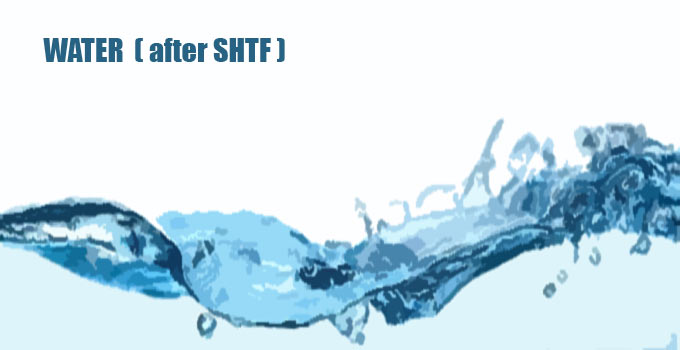Water Management After SHTF (What You Need To Do)

As most of you know, WATER is #1 when it comes to general preparedness.
Most take it for granted that there’s plenty of available water. An endless supply coming from your faucet.
Maybe in the back of your mind you know that there’s a pond, lake, or stream not too far from where you live. Or maybe the fact that you have a well is giving you a false sense of security.
However there are several issues that you should think about, just in case…
1. Water Storage for short term issues.
2. Water Storage for long term.
3. Replenishment of your water storage.
4. Water filtration.
5. Waste disposal issues.
Water Storage (short term)
This is easy! It doesn’t apply too much towards “SHTF” water management, but it will provide some convenience.
– Simply purchase a number of cases of bottled water.
– Also purchase a few water containers for water storage.
The first is simple. Go to the grocery store and buy cases of water.
The second part will provide more storage. Since water weighs 8 pounds per gallon, containers that are sized between 3 and 7 gallons will be more manageable.
Water Storage (long term)
While you can only store so much water due to its weight and volume constraints (physical space required), the next step is to store larger quantities of water.
I use several “Olive barrels” that I acquired a number of years ago (originally adapted for water rainwater collection). They hold about 50 gallons of water each.
There are a number of options in this area and purpose built 55 gallon water storage barrels. If you have the space, I would recommend something like this to store a greater volume of water for just in case…
They’re not cheap, but it is “cheap insurance”.
Water Storage (replenishment)
THIS IS IMPORTANT!
Your stored water is only going to last so long. Then it will be gone.
To put it in perspective, read this and then come back…
The Average Gallons Of Water People Consume Each Day
The key to post-SHTF water management survival will be the ability to replenish.
Give this some very serious thought. If you’re truly planning long term SHTF survival, you WILL need water to survive.
Examine your geographical area. Find sources of water.
Just as important will be the ability to transport that water back to your base of operations. You will need water containers and a mode of transportation. Will your vehicle be operational? Maybe you better think about a yard cart (large diameter wheels are better). Maybe a 2-wheel dolly. You get the idea…
Rubbermaid Commercial Big Wheel Yard Cart
Water Filtration & Purification
It should go without saying that you will need a GOOD WATER FILTER for drinking safely.
I’ve posted about water filters a zillion times (you can search the site). That said, choose what’s best for you. I recommend at least having a good countertop model as your base station drinking water supply.
And if you know me, you know that I will recommend the Berkey. They have several countertop sizes. But this is the one I like the best (adequate size and comes with a see-through level indicator).
Bob over at ReadyMadeResorces is another long time sponsor here. Please check out his lineup of Seychelle water filters (some of them are radiological filters!).
Seychelle Water Filtration Systems
Check out his complete lineup of Water Filter Systems (Here)
Grey & Black Water Disposal
This is a tough one. I will say this… If you have a septic tank you are in great shape! No worries regarding water disposal (grey or black).
However, if you are living like most people you rely on your town’s sewage system for your waste water disposal.
I know that I did not define ‘SHTF’ for the context of this article. I do that on purpose (usually) to simply get people thinking about it however they wish. Different scenarios bring on varying circumstances.
With that said, if your sewer systems become “backed up”, you might be in for some nasty issues. The higher up in town you are, the less likely you will be affected.
I will suggest that you consider one of these if you’re concerned about sewage backing up into your home under extreme conditions. It’s an expandable sewer plug designed to stop up sanitary lines. It will prevent backflow if inserted at the sewage outlet from your home. It’s purpose is to test the integrity of home sanitary lines during installation (pressure test and such), however useful as I describe.
However you would then be confronted with where to divert your grey and black water! That’s not going to be easy.
Your internal plumbing drains including your toilet will be rendered inoperable if you stop up your sewage outlet. That means taking care of business somewhere else. Outside. Or elsewhere.
Now you’re looking at wash buckets, alternative toilet (building an outhouse?), and on top of that you’re dealing with weather conditions depending on the season.
Getting back to the likelihood of your city or town’s waste disposal system actually backing up… Remember that all water flows downhill unless pumped. Most municipal sewage treatment plants are located at or near a low point in town. And many of these will have a means of emergency runoff (although quite unsanitary for anyone ‘downstream’ so to speak).
So an actual backup (without operational pumps) may or may not occur.
Hopefully this article has inspired some thought about water management after SHTF.
Lets hear your ideas and opinion…
